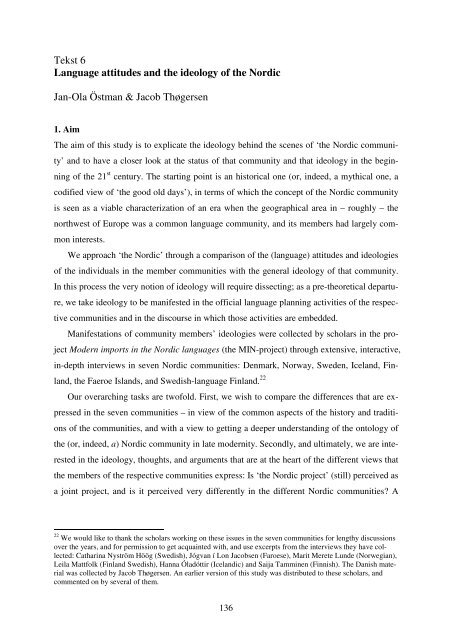Hør dog hvad de siger - Note-to-Self: Trials & Errors
Hør dog hvad de siger - Note-to-Self: Trials & Errors
Hør dog hvad de siger - Note-to-Self: Trials & Errors
You also want an ePaper? Increase the reach of your titles
YUMPU automatically turns print PDFs into web optimized ePapers that Google loves.
Tekst 6<br />
Language attitu<strong>de</strong>s and the i<strong>de</strong>ology of the Nordic<br />
Jan-Ola Östman & Jacob Thøgersen<br />
1. Aim<br />
The aim of this study is <strong>to</strong> explicate the i<strong>de</strong>ology behind the scenes of ‘the Nordic communi-<br />
ty’ and <strong>to</strong> have a closer look at the status of that community and that i<strong>de</strong>ology in the begin-<br />
ning of the 21 st century. The starting point is an his<strong>to</strong>rical one (or, in<strong>de</strong>ed, a mythical one, a<br />
codified view of ‘the good old days’), in terms of which the concept of the Nordic community<br />
is seen as a viable characterization of an era when the geographical area in – roughly – the<br />
northwest of Europe was a common language community, and its members had largely com-<br />
mon interests.<br />
We approach ‘the Nordic’ through a comparison of the (language) attitu<strong>de</strong>s and i<strong>de</strong>ologies<br />
of the individuals in the member communities with the general i<strong>de</strong>ology of that community.<br />
In this process the very notion of i<strong>de</strong>ology will require dissecting; as a pre-theoretical <strong>de</strong>partu-<br />
re, we take i<strong>de</strong>ology <strong>to</strong> be manifested in the official language planning activities of the respec-<br />
tive communities and in the discourse in which those activities are embed<strong>de</strong>d.<br />
Manifestations of community members’ i<strong>de</strong>ologies were collected by scholars in the pro-<br />
ject Mo<strong>de</strong>rn imports in the Nordic languages (the MIN-project) through extensive, interactive,<br />
in-<strong>de</strong>pth interviews in seven Nordic communities: Denmark, Norway, Swe<strong>de</strong>n, Iceland, Fin-<br />
land, the Faeroe Islands, and Swedish-language Finland. 22<br />
Our overarching tasks are twofold. First, we wish <strong>to</strong> compare the differences that are ex-<br />
pressed in the seven communities – in view of the common aspects of the his<strong>to</strong>ry and traditi-<br />
ons of the communities, and with a view <strong>to</strong> getting a <strong>de</strong>eper un<strong>de</strong>rstanding of the on<strong>to</strong>logy of<br />
the (or, in<strong>de</strong>ed, a) Nordic community in late mo<strong>de</strong>rnity. Secondly, and ultimately, we are inte-<br />
rested in the i<strong>de</strong>ology, thoughts, and arguments that are at the heart of the different views that<br />
the members of the respective communities express: Is ‘the Nordic project’ (still) perceived as<br />
a joint project, and is it perceived very differently in the different Nordic communities? A<br />
22 We would like <strong>to</strong> thank the scholars working on these issues in the seven communities for lengthy discussions<br />
over the years, and for permission <strong>to</strong> get acquainted with, and use excerpts from the interviews they have collected:<br />
Catharina Nyström Höög (Swedish), Jógvan í Lon Jacobsen (Faroese), Marit Merete Lun<strong>de</strong> (Norwegian),<br />
Leila Mattfolk (Finland Swedish), Hanna Óladóttir (Icelandic) and Saija Tamminen (Finnish). The Danish material<br />
was collected by Jacob Thøgersen. An earlier version of this study was distributed <strong>to</strong> these scholars, and<br />
commented on by several of them.<br />
136



